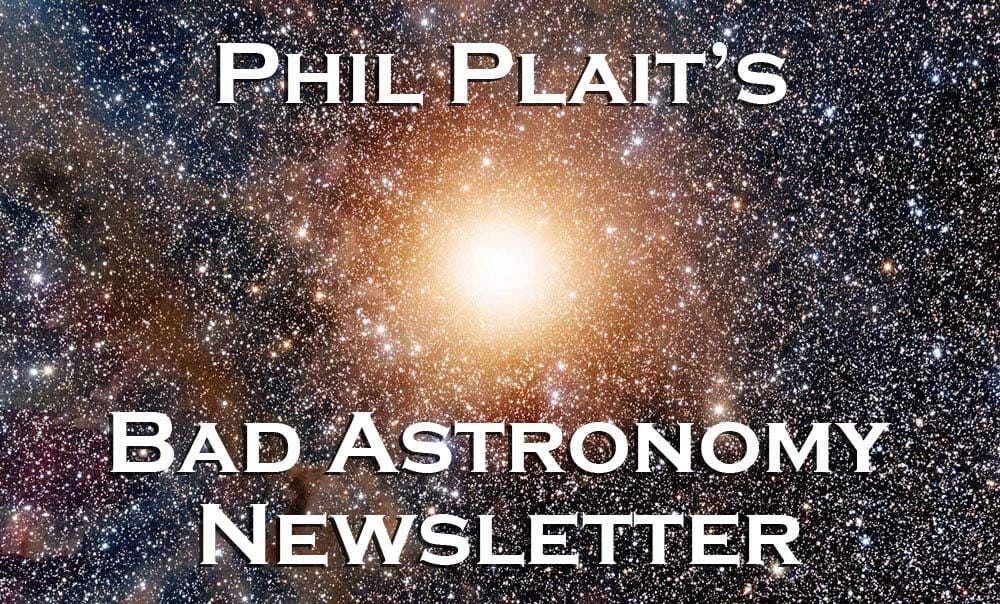- Bad Astronomy Newsletter
- Posts
- New JWST image shows a colossal tantrum from a young star. Bonus coincidental galaxy, too!
New JWST image shows a colossal tantrum from a young star. Bonus coincidental galaxy, too!
“Cosmic Tornado” seen clearly in new images. Also: Light pollution in central Virginia
March 27, 2025 Issue #857
How to see the partial solar eclipse this Saturday!
On March 29th, 2025, the Moon will partially eclipse the Sun! This is visible from the US northeast, parts of eastern Canada, and north Atlantic areas like Iceland, Greenland, and western Europe. For US observers it happens early in the morning around sunrise. I have details like where and when it’s visible and how to see it in an article I wrote for Condé Nast Traveler.
It’s not visible for me where I live in central Virginia; the eclipse ends just before sunrise. However, I’ll be at GalaxyCon in Richmond on Saturday morning, which is far enough east of me that it ends just after sunrise. If I get a hotel room that faces east and is high enough I should get a pretty interesting view for a minute or two, with the Moon just barely clipping the Sun’s edge. That’ll be fun to try for!
“Cosmic tornado” touches down in a background galaxy
Older images were ambiguous but JWST clears up a young star’s blast of material
I love Herbig-Haro Objects. These are long, narrow beams of material (astronomers call them jets) that shoot away from very young stars, creating beautiful and weird structures in space. They’ve been seen for decades but we’re only now beginning to understand the physics that launches them. Even still, many mysteries remain.
Part of the problem has been images of them haven’t been super clear. Sure, Hubble images do a great job of showing them, and have helped a lot. But as the ejected material blasts into space it interacts with gas and dust floating in between stars — and there’s a lot in the environment where stars are born, since they form in dense clouds of this stuff — shaping and molding them. A lot of that interaction makes the material warm, so it glows in infrared light, and IR telescopes haven’t been up to the task of seeing this clearly.
|
Until now, because we have JWST. It’s designed to see infrared light, and has sharp enough vision to really clear up a lot of what was only seen murkily before.
A fine example is HH 49/50, a Herbig-Haro object about 500 light-years away in the constellation Chamaeleon. Its infrared light was observed by the Spitzer Space Telescope in 2006, but Spitzer was a small ‘scope and the image was fuzzy. There was also a weird star-like object near the end of the jet that was surrounded by what looks like gas. Was that associated with the jet, or a background object?
Turns out the latter, because JWST got a great shot of it:

HH 49/50 seen by JWST. The object at the tip is a background galaxy. Credit: NASA, ESA, CSA, STScI
Aha!
OK, first of all, how gorgeous is that jet? Its source is a very young star called Cedarblad 110 IRS4, which is located off to the lower right, outside the field of this image. The star is still forming, gathering material from the nebula around it. This forms a swirling disk around it, which has an embedded magnetic field. Near the star the field gets wound up, creating a lot of pressure. So much so that the material falling toward the star gets blown upward and downward, away from the disk, focused by the wound-up magnetic fields into a highly collimated stream (the jet). As it plows through the material around it at speeds of three hundred thousand kilometers per hour (!!) it forms the cone shape, like the wake off a boat moving through water. The smaller fingers of stuff in it are likely where it hits slightly denser material, and/or the location of turbulence in the jet.
In this image, cold molecular hydrogen is shown in orange, and grains of dust (rocky and sooty material) in red.
And the object at the tip, fuzzily seen in earlier images? No doubt what it is now: a background spiral galaxy. In these infrared filters, old stars in the center of the galaxy appear blue, and star-forming nebulae in the spiral arms look red. We’ve seen tons of spiral galaxies with JWST that look similar. Mystery solved!
Interestingly, there’s another structure apparently coming off the jet near the top on the right (it can be seen in the Spitzer shot as well). What is that?

Subscribe to Premium to read the rest.
Become a paying subscriber of Premium to get access to this post and other subscriber-only content.
Already a paying subscriber? Sign In.
A subscription gets you:
- • Three (3!) issues per week, not just one
- • Full access to the BAN archives
- • Leave comment on articles (ask questions, talk to other subscribers, etc.)



Reply